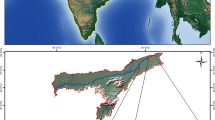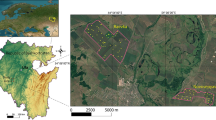Abstract
The influence of erosion degree and slope aspect on the structural composition of typical chernozems (Haplic Chernozems) and the qualitative characteristics of organic matter in these soils were studied. We determined the organic carbon content in separate structural units of the soils under different agroecological conditions of Kursk oblast. Aggregates of 3–1 mm in size played the decisive role in the structural state of typical chernozems; their total content and the content of carbon of organic compounds in them were higher than those for the aggregates of 10–3 and <1 mm in size. The contribution of organic matter and labile humic substances to the formation of water-stable soil aggregates was also considered. A tendency for an increase in the diameter of aggregates with an increase in their organic carbon content was displayed in the soils independently from the degree of their erosion. The content of carbon of labile humic substances in water-stable aggregates of the soils on north-facing slopes was higher than that in the soils on south-facing slopes. With an increase in the portion of labile humus participating in the formation of water-stable aggregates of typical chernozems, the diameter of these aggregates increased from 0.5–0.25 to 3–1 mm. This regularity was clearly displayed in the Ap and A horizons of typical chernozems on the interfluve and on the north-facing slope and in the Ap horizon of these soils on the south-facing slopes independently from the degree of soil erosion. The results of this study may be used in methodological recommendations on regulation of the aggregate and humus states of typical chernozems in agrolandscapes with sloping topography.





Similar content being viewed by others
REFERENCES
I. N. Antipov-Karataev and A. P. Rabinerson, “The study of soil colloids,” Tr. Leningr. Otd., Inst. Udobr. Agropochvoved., No. 10, (1930).
O. G. Bushueva, A. V. Gorobets, N. G. Dobrovol’skaya, Z. P. Kiryukhina, G. A. Larionov, and L. F. Litvin, “Destruction of inter-aggregate bonds between soil particles in the course of water erosion,” Byull. Pochv. Inst. im. V.V. Dokuchaeva, No. 78, 20–30 (2015).
A. F. Vadyunina and Z. A. Korchagina, Methods for Studying Soil Physical Properties (Agropromizdat, Moscow, 1986) [in Russian].
A. D. Voronin, Fundamentals of Soil Physics (Moscow State Univ., Moscow, 1986) [in Russian].
E. A. Dmitriev, Mathematical Statistics in Soil Science (Moscow State Univ., Moscow, 1972) [in Russian].
V. V. Dokuchaev, Our Steppes Before and Now (1892): Collection of Research Works (Nauka, Moscow, 1952) [in Russian].
B. A. Dospekhov, Methods of Field Experiments with Statistical Data Analysis (Kolos, Moscow, 1979) [in Russian].
M. N. Zaslavskii and A. N. Kashtanov, Soil-Protective Farming (Rossel’khozizdat, Moscow, 1979) [in Russian].
N. A. Kachinskii, Soil Physics (Moscow, 1965), Part 1 [in Russian].
V. I. Kiryushkin, Agronomic Soil Science (Kolos, Moscow, 2010) [in Russian].
Classification and Diagnostics of Soils of the Soviet Union (Kolos, Moscow, 1977) [in Russian].
L. L. Shishov, V. D. Tonkonogov, I. I. Lebedeva, and M. I. Gerasimova, Classification and Diagnostic System of Russian Soils (Oikumena, Smolensk, 2004) [in Russian].
B. M. Kogut, S. A. Sysuev, and V. A. Kholodov, “Water stability and labile humic substances of typical chernozems under different land uses,” Eurasian Soil Sci. 45, 496–502 (2012).
A. G. Kremlev, Mathematics: Section Statistics (Ural State Law Acad., Yekaterinburg, 2001) [in Russian].
I. V. Kuznetsova, V. F. Utkaeva, and A. G. Bondarev, “ Normatives of changes in the physical properties of chernozems in the forest-steppe zone of European Russia under conditions of their intensive agricultural use,” Eurasian Soil Sci. 46, 1194–1202 (2013).
N. P. Masyutenko, B. M. Kogut, O. V. Kiseleva, E. V. Dubovik, G. P. Glazunov, and T. I. Pankova, The Structure of Ordinary Chernozem and the Content of Organic Carbon and Labile Humic Substances in Soil Aggregates (All-Russia Research Institute of Arable Farming and Soil Erosion Control, Kursk, 2008) [in Russian].
M. A. Nakonechnaya and V. E. Yavtushenko, “Humus losses on slope soils of the central chernozemic region,” Pochvovedenie, No. 5, 19–26 (1989).
I. A. Netesonova, Candidate’s Dissertation in Biology (Moscow, 2010).
Recommendations for Analysis of Balance and Transformation of Organic Matter during Agricultural Use and Intensive Cultivation of Soils (Moscow, 1984) [in Russian].
V. M. Semenov and B. M. Kogut, Soil Organic Matter (GEOS, Moscow, 2015) [in Russian].
G. P. Surmach, Relief Formation, Forest-Steppe Development, Modern Erosion, and Erosion Control Measures (All-Union Research Institute of Agroforestry, Volgograd, 1992) [in Russian].
Yu. P. Sukhanovskii, A. V. Prushchik, Yu. A. Solov’eva, and S. I. Sanzharova, “Permissible losses of soils due to erosion and problem solution,” Byull. Pochv. Inst. im. V.V. Dokuchaeva, No. 78, 3–19 (2015).
D. D. Khaidapova, V. V. Chestnova, E. V. Shein, and E. Yu. Milanovskii, “Rheological properties of typical chernozems (Kursk oblast) under different land uses,” Eurasian Soil Sci. 49, 890–897 (2016). https://doi.org/10.1134/S1064229316080044
D. V. Khan, Organomineral Compounds and Soil Structure (Nauka, Moscow, 1969) [in Russian].
E. V. Shein and L. O. Karpachevskii, Explanatory Dictionary of Soil Physics (GEOS, Moscow, 2003) [in Russian].
E. V. Shein and E. Yu. Milanovskii, “The role of organic matter in the formation and stability of soil aggregates,” Eurasian Soil Sci. 36, 51–58 (2003).
V. F. Yurinskaya, “Specific microbiological activity in typical chernozems depending on their washing, element and slope exposure,” Pochvozashch. Zemledelie, No. 1 (36), 54–60 (1983).
C. J. Bronick and R. Lal, “Soil structure and management: a review,” Geoderma 124, 3–22 (2005).
B. Dobrzanski, B. Witkowska, and R. Walczak, “Soil aggregation and water stability index,” Pol. J. Soil Sci. 8 (1), 3–8 (1975).
E. T. Elliott, “Aggregate structure and carbon, nitrogen, and phosphorus in native and cultivated soils,” Soil Sci. Soc. Am. J. 50, 627–633 (1986).
J. D. Jastrow, R. M. Miller, and T. W. Boutton, “Carbon dynamics of aggregate-associated organic matter estimated by carbon-13 natural abundance,” Soil Sci. Soc. Am. J. 60, 801–807 (1996).
J. D. Jastrow, “Soil aggregate formation and the accrual of particulate and mineral-associated organic matter,” Soil Biol. Biochem. 28, 657–676 (1996).
B. John, T. Yamashita, B. Ludwig, and H. Flessa, “Storage of organic carbon in aggregate and density fractions of silty soils under different types of land use,” Geoderma 128, 63–79 (2005).
J. M. Oades and A. G. Water, “Aggregate hierarchy in soils,” Aust. J. Soil Res. 29, 815–828 (1991).
P. Puget, C. Chenu, and J. Balesdent, “Total and young organic matter distributions in aggregates of silty cultivated soils,” Eur. J. Soil Sci. 46, 449–459 (1995).
J. Six, K. Paustian, E. T. Elliott, and C. Combrink, “Soil structure and organic matter. I. Distribution of aggregate–size classes and aggregate–associated carbon,” Soil Sci. Soc. Am. J. 64, 681–689 (2000).
World Reference Base for Soil Resources 2014, International Soil Classification System for Naming Soils and Creating Legends for Soil Maps, World Soil Resources Report No. 106 (Food and Agriculture Organization, Rome, 2015).
Author information
Authors and Affiliations
Corresponding author
Additional information
Translated by L. Kholopova
Rights and permissions
About this article
Cite this article
Dubovik, E.V., Dubovik, D.V. Relationships between the Organic Carbon Content and Structural State of Typical Chernozem. Eurasian Soil Sc. 52, 150–161 (2019). https://doi.org/10.1134/S1064229319020042
Received:
Revised:
Accepted:
Published:
Issue Date:
DOI: https://doi.org/10.1134/S1064229319020042




